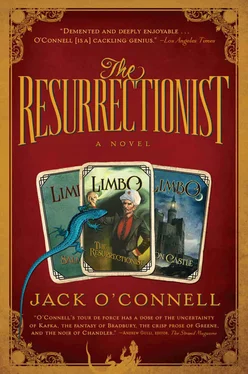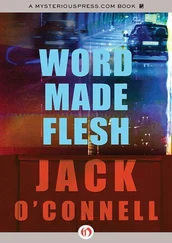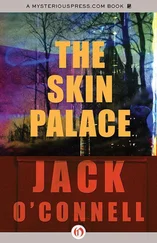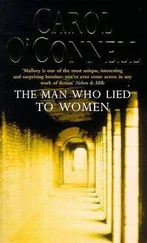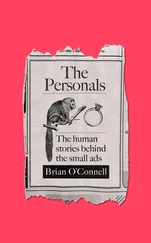Jack O'Connell - The Resurrectionist
Здесь есть возможность читать онлайн «Jack O'Connell - The Resurrectionist» весь текст электронной книги совершенно бесплатно (целиком полную версию без сокращений). В некоторых случаях можно слушать аудио, скачать через торрент в формате fb2 и присутствует краткое содержание. Год выпуска: 2009, Издательство: Algonquin Books, Жанр: Современная проза, на английском языке. Описание произведения, (предисловие) а так же отзывы посетителей доступны на портале библиотеки ЛибКат.
- Название:The Resurrectionist
- Автор:
- Издательство:Algonquin Books
- Жанр:
- Год:2009
- ISBN:нет данных
- Рейтинг книги:4 / 5. Голосов: 1
-
Избранное:Добавить в избранное
- Отзывы:
-
Ваша оценка:
- 80
- 1
- 2
- 3
- 4
- 5
The Resurrectionist: краткое содержание, описание и аннотация
Предлагаем к чтению аннотацию, описание, краткое содержание или предисловие (зависит от того, что написал сам автор книги «The Resurrectionist»). Если вы не нашли необходимую информацию о книге — напишите в комментариях, мы постараемся отыскать её.
those who create them and those who consume them. About the nature of consciousness and the power of the unknown. And, ultimately, about forgiveness and the depth of our need to extend it and receive it.
The Resurrectionist — читать онлайн бесплатно полную книгу (весь текст) целиком
Ниже представлен текст книги, разбитый по страницам. Система сохранения места последней прочитанной страницы, позволяет с удобством читать онлайн бесплатно книгу «The Resurrectionist», без необходимости каждый раз заново искать на чём Вы остановились. Поставьте закладку, и сможете в любой момент перейти на страницу, на которой закончили чтение.
Интервал:
Закладка:
29
Peck had placed the terrarium on the metal cart next to him, among the rest of his tools. From this vantage, Rene, the salamander, had a fine view of the procedure as it began to unfold. To some degree, the newt’s vision was affected by the curve of the glass bowl, which bent the light a bit and added just a touch of magnification.
The doctors were dressed in deep green gowns and caps. Their masks hung down at their necks, leaving their faces visible. The younger doctor seemed slightly manic, too jovial, bouncing on his feet, his gloved hands clasped tightly behind his back. The older doctor was serious if not severe. He stood at the head of the slab, a safety razor in one hand. The other hand held a swatch of gauze that he used to dab away the shaving cream.
“I’ve never trusted a surgeon,” Peck said to Tannenbaum, “who doesn’t personally shave his patient.”
Tannenbaum mumbled his agreement, but his focus was on the structure framing and confining the child’s skull.
“Everything today is about speed,” Dr. Peck said. “About efficiency and economy.”
The skull was held rigid within a gleaming metal halo that circled around the forehead, just above the delicate ears and the blond eyebrows.
“You’d think we were accountants,” Peck said, a touch dreamily, but still in his lecture voice, “or train conductors.”
The halo, in turn, connected to a series of metal rods, which formed an open cube and bolted to the surgical slab. The device was, Tannenbaum knew, the doctor’s own invention and construction. Just as he knew that he would be acting as little more than instrument nurse throughout the procedure.
As if reading his thoughts, Peck handed his aide the straight razor and foamy gauze, then left his cutting hand extended, all the while continuing to stare at the boy’s skull, as if it were a newly discovered planet. Tannenbaum took the refuse and placed it on the cart, grabbed a fat marking pen and slapped it into the doctor’s waiting palm.
Peck uncapped the pen and brought its tip to the bare scalp, drew a crosshair in the appropriate location and darkened its intersection with a bull’s-eye.
“Science has been degraded,” Peck said to the room. “What was once a vocation has become a profession.”
He recapped the pen, returned it to Tannenbaum. On the instrument cart, resting on a sheet of emerald cotton next to Danny’s bulging medical file, was a collection of Peck family heirlooms — the straight razor with its scrimshaw handle, the steel cannula that had been brought back from a trip to Germany in the ’30s, and the 150-year-old glass syringe, its bulging crystal bulb full of raw potentiality.
While he had hoped to use only Father’s instruments for this procedure, in the end Peck had chosen a state-of-the-art Kopf stereotactic drill to bore through the skull. It was a beautiful piece of equipment — a hand unit, battery operated, with a flexible shaft and a speed range up to fourteen thousand revolutions per minute. The drill weighed only five ounces and accepted a wide variety of shanks and bits. For this case, the doctor had selected a diamond bit to make the opening.
Peck lifted the drill, switched it on and listened to the hum of the motor, eyes closing for just a second as if trying to place the title of an obscure sonata. The procedure itself was a relatively simple operation. The optimum site for reseeding — in the center of the disaster area, in the superior aspect of the basal ganglia — had been identified through CT scans. The doctor would cut through the dura with the craniotomy, then insert a stabilizing probe, plant Father’s syringe, and slowly inject the contents of the crystal bulb — six million cells of potential consciousness. A personal wake-up call from Dr. Peck.
He shut the motor down and looked at his protégé.
“To be a doctor,” he said, “is to accept a responsibility that most men can’t comprehend.”
Tannenbaum nodded, uneasy with the pronouncement, wanting to get on with the operation.
“We’re not like other people,” Peck continued. “A real doctor, a true physician, is a person set apart. We’re a caste unto ourselves. We live outside the tribe. But we’re responsible for its health.”
“It’s a great obligation,” Tannenbaum said, because he felt a response was needed.
“I’m not speaking here,” Peck said, “about viruses and infections. Fevers and broken bones.”
“Of course not,” Tannenbaum said.
“I’m speaking,” Peck said, “about the essential well-being of the race itself. The protection and advancement of the species.”
Tannenbaum nodded, his mask bouncing against his throat.
“I need you to understand what’s at stake here,” Peck said, “I need you to witness the magnitude and the meaning of what we’re about to do.”
“We’re going to bring the boy back,” Tannenbaum blurted and immediately regretted his words.
Peck stared at the younger doctor suspiciously for a second, then pulled the mask up to cover the lower half of his face. Without taking his eyes off his assistant, he thumbed on the drill once again and the noise of its motor filled the theater.
Tannenbaum reached down and lifted the antique syringe gingerly, cradling the glass bulb full of saline and fetal cells. Peck motioned for the young doctor to stand on the other side of the slab, where he’d have an unobscured view of the implantation.
Peck positioned himself directly behind the child’s skull, the red bull’seye looking scarlet under the yellow lights and against the milky white canvas of the boy’s skin. Hunching, the doctor stepped in close and adjusted his weight across his hips, the way his father had advised so many years ago. He felt the control in his arms and hands; his muscles and nerves confident, assured, tremor-free. He could sense himself sliding into that place beyond thought, like a monk or an athlete, ready to fulfill his only reason for being. He brought the drill forward and made ready to bore into the boy’s head.
And in that instant, the salamander began to react to the vibrations that were rolling forward down the hallway. Rene shifted his gaze from the doctor’s hands to the theater’s entrance, just as the doors were kicked open with enough force to snap both of the hinges.
At the sound of the tearing metal, Peck simultaneously pulled back from the skull and began to turn toward the doors, just in time to have the drill batted out of his hands. It fell to the floor, still purring. The surgical theater was suddenly full of bodies. Three men, huge and hairy, screaming obscenities, dressed in leather and fur and denim, rushed inside, followed by the patient’s father and one of the clinic nurses.
The largest of the invaders, the Elephant, immediately grabbed the syringe from Tannenbaum and hurled it, shattering the bulb and showering the wall. Then the biker took Tannenbaum’s throat in one hand and, seizing his crotch through his gown, lifted the young doctor horizontally into the air and heaved him against the wall, where he crashed into and dislodged the display of antique surgical instruments before falling to the ground. In full adrenaline rush, the Elephant ran toward the crumpled pile of doctor and began kicking and stomping along the prone body. The sound of bones snapping was audible until Sweeney yelled, “Don’t kill him. Don’t kill either one of them.”
As Tannenbaum’s bones broke, Peck was knocked to the floor by a euphoric Piglet, then lifted up and held in place by Nadia and the Fluke. Sweeney made himself wait while Piglet drove a knee into Peck’s groin, then brought the cowering doctor upright again with two uppercuts to the head. Then Piglet noticed the drill still whirring away on the ground. He squatted quickly to snatch it, but stood slowly, as if savoring the many kinds of damage he could do with this tool. Positioning the drill before Peck’s forehead, he said, “How ’bout I cut this asshole a third eye?”
Читать дальшеИнтервал:
Закладка:
Похожие книги на «The Resurrectionist»
Представляем Вашему вниманию похожие книги на «The Resurrectionist» списком для выбора. Мы отобрали схожую по названию и смыслу литературу в надежде предоставить читателям больше вариантов отыскать новые, интересные, ещё непрочитанные произведения.
Обсуждение, отзывы о книге «The Resurrectionist» и просто собственные мнения читателей. Оставьте ваши комментарии, напишите, что Вы думаете о произведении, его смысле или главных героях. Укажите что конкретно понравилось, а что нет, и почему Вы так считаете.
